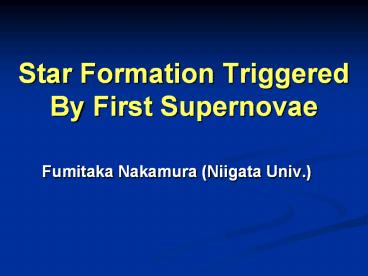Star Formation Triggered By First Supernovae - PowerPoint PPT Presentation
Title:
Star Formation Triggered By First Supernovae
Description:
What is the typical mass of the first stars? Can first supernovae trigger subsequent star formation? ... Nakamura, McKee, & Klein (in prep. ... – PowerPoint PPT presentation
Number of Views:25
Avg rating:3.0/5.0
Title: Star Formation Triggered By First Supernovae
1
Star Formation Triggered By First Supernovae
- Fumitaka Nakamura (Niigata Univ.)
2
Questions
- What is the typical mass of the first stars?
- Can primordial cloud cores break up into multiple
fragments? - Binary formation?
- Can first supernovae trigger subsequent star
formation?
- What is the typical mass of the stars formed by
shock compression? - low mass star formation? (e.g., HE0107-5240)
3
What is the typical mass of first stars?
- Typical mass of fragments 100M8
- No fragmentation for the polytrope gas with g
1.1. - (e.g., Tsuribes talk)
Size of HII region 100 pc Free-fall time of
fragments 106yr ? Positive feedback of UV
radiation ? Enhanced H2 formation
30 pc
(Bromm, Coppi, Larson 1999)
- If a truly first star is massive, it emits strong
UV radiation, which should affect subsequent
evolution of other prestellar fragments.
4
Positive feedback of UV radiation
- Enhanced H2 formation
HD cooling is more dominant for T lt 100 200 K
5
Thermal Property of Primordial Gas for HD
Controlled Case
- H2 controlled collapse
- HD controlled collapse
g 1.1
sphere
Temperature
cylinder
density
Machida et al. (in prep.)
Omukai 2000
6
Summary part 1 typical mass of first generation
stars
- Truly first stars may be very massive as 100 M8.
- But, many first generation stars may have masses
of 1040 M8. - Massive binary stars may be common product.
Effect of HD cooling !
Fragmentation !
HD cooling
7
Can First Supernovae Trigger Subsequent Star
Formation?
Supernovae of first stars
8
Evolution of SNR
cooling
adiabatic
1. Free expansion
2. Sedov-Taylor
3. Pressure-driven expansion
Step 1 1D calculation We follow the evolution of
the SNR shell with the thin-shell approximation.
Dynamical evolution analytic model Thermal
evolution radiative cooling time-dependent
chemical evolution
9
Evolution of SNR Step 1
Machida et al. (in prep.)
Radius and expansion velocity
Evolution of density
Evolution of temperature
10
Formation of Self-Gravitating Shells
- The cooling shell is expected to become
self-gravitating by the time 106 - 107 yr.
Formation of self-gravitating Shell ? Tff Tdyn
Tff
Tcool
Tdyn
Texp
Texp is sufficiently longer than Tff and Tdyn at
the final stage.
11
Fragmentation of Cooling Shells Step 2
- Fragmentation of a self-gravitating sheet
- Thin-disk approximation
- isothermal EOS
- Power law velocity fluctuations
- 2D hydro simulation
Nakamura Li (in prep.)
12
Fragmentation of Cooling Shells
- Mass fraction of dense regions reaches 0.7.
- ? star formation efficiency may be high.
M Mach number of the velocity perturbations
- Dense cores are rotating very rapidly.
13
Fragmentation Condition of SNR
- The shell should be self-gravitating before blow
out. - Expansion velocity should be larger than the
sound speed.
14
Summary part2 Star Formation Triggered by First
Supernovae
Supernovae of first stars
SNR
Shock-cloud interaction
Fragmentation of cooling shells
Compression of cloud cores
Complete mixing
No mixing
1M8.
Induced SF
Z 10-3Z8
HD cooling
Formation of low-mass metal-free stars
Metal cooling
Formation of massive metal-free stars
10-40M8.
Similar to present-day SF
1M8.
15
Effect of Mixing
The temperature goes down to 20-40 K.
- Dense cores are rotating very rapidly.
- ? binary formation
- Dense cores may fragment into small cores with
masses of 1 M8. - The efficiency of star formation may be high.
16
Shock-Cloud Interaction
- Shock can trigger gravitational collapse before
KH instability grows significantly.
The density can become greater than 104 cm-3 for
nearly isothermal case.
Polytrope gas, 2D axisymmetric, no self-gravity
Nakamura, McKee, Klein (in prep.)
Fragmentation into 1M8 cores is expected due to
efficient H2 cooling by three-body reaction.































